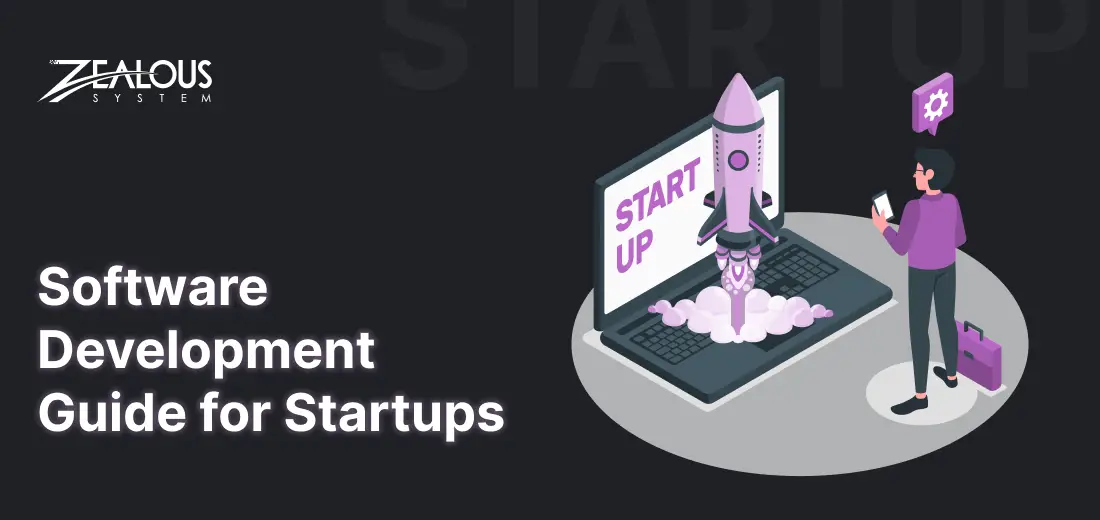
We use cookies and similar technologies that are necessary to operate the website. Additional cookies are used to perform analysis of website usage. please read our Privacy Policy
The Ultimate Software Development Guide For Startups

For any business today, startup or large scale, software development has become the ticket to that front seat. Especially in a world that changes faster than Instagram trends, being able to adapt and innovate is not just an advantage but a necessity.
No matter what type of business you own, you will need mobile apps and online platforms as they have a high impact on the way customers reach out to you and buy your products or services. Projections indicate that the software development market will soar to $1039 million by 2027, with an impressive CAGR of 22.54% from 2020 to 2027.
For startups, software development goes beyond coding – it’s about creating a robust and scalable digital tool that effectively addresses real-world problems.
So, if you are a tech enthusiast looking for a guide for your startup software development idea, this is the perfect guide for you. Well, why? Because, as a custom software development company, we have been helping startups like yours turn their raw ideas become people-loving digital products in reality.
Follow this step-by-step process for a seamless journey through digital product development.
Let’s delve into it
Brief Overview Of The Importance Of Software Development For Startups
Software development plays a crucial role in the success of startups. It allows startups to transform their innovative ideas into tangible products that can be used by customers. Here’s top five benefits of software development for startups that you can count on –
Enhanced Customer Reach
Mobile apps and online platforms provide startups with a direct and accessible channel to connect with their target audience. A well-developed software solution allows startups to reach a broader customer base, transcending geographical limitations.
For instance, a local startup in the food delivery sector experienced a 40% surge in orders after introducing a user-friendly mobile app, allowing customers to conveniently browse and place orders.
Improved Customer Engagement
Software development enables startups to create interactive and user-friendly interfaces, enhancing the overall customer experience. Features like chatbots, personalized notifications, and seamless navigation keep users engaged and satisfied.
Efficient Operations
Custom software solutions streamline internal processes, improving operational efficiency for startups. Automation of routine tasks, data management, and communication processes saves time and resources.
A logistics startup optimized its supply chain operations with a tailored software solution, resulting in a 30% decrease in manual errors and a 25% increase in delivery speed.
Data-Driven Decision Making
Software development facilitates the collection and analysis of valuable data.
Startups can leverage data insights to make informed decisions, identify trends, and adapt strategies based on customer behavior and market trends.
Scalability and Adaptability
Well-designed software solutions are scalable, allowing startups to accommodate growth without major disruptions. The adaptability of software enables quick adjustments to changing market conditions and business requirements.
A tech startup experienced a surge in user registrations, and its scalable software infrastructure effortlessly handled a 50% increase in user traffic without system glitches, ensuring a smooth user experience.
Startup Software Development Process: Step-by-Step Guide
As a software development company based in Australia, our experts have curated a step-by-step guide to help you navigate the various stages of software development:
1. Ideation and Conceptualization
During the ideation phase, you’re exploring the concept thoroughly, thinking about whether it’s doable, what value it brings, and how it stands out from the competition. It’s like creating the blueprint for a solution to a real-world problem.
In the ideation process of software development for a startup, it’s crucial to explore the concept thoroughly, considering its feasibility, value proposition, and potential impact. This involves brainstorming sessions, market research, and competitor analysis to refine the idea and lay the foundation for a successful product.
You can consider leveraging collaborative tools for brainstorming, like virtual whiteboards or idea management platforms and market research tools to analyze trends and competitor strategies. Platforms such as Google Trends and SEMrush can provide valuable insights into the demand for similar situations.
2. Requirements Gathering and Analysis
Once the concept has been validated and the decision to pursue development has been made, the next step is to gather and analyze requirements. This involves understanding the needs and expectations of the target users, as well as the business objectives that the software aims to achieve.
Through interviews, surveys, and workshops, you’re collecting requirements and understanding what users need. This phase is about creating a roadmap that guides your development journey based on user needs and business goals.
For requirements gathering, employ tools like Jira or Trello to document user stories and feature requests. Conduct user interviews using video conferencing tools like Zoom or Microsoft Teams. Analyze data using tools like Google Analytics to understand user behavior on existing platforms and gather quantitative insights.
3. Design and Prototyping
As you move into the design phase, you become an architect of user experiences. Working with designers and engineers, you’re creating the visual identity of your product. Wireframes and prototypes give you a sneak peek into how users will interact with your creation. It’s like watching your idea transform from words on a page to a tangible, interactive concept.
In the design phase, utilize design tools like Figma or Adobe XD for creating wireframes and interactive prototypes. Collaborate seamlessly using version control systems like Git to manage design iterations. Conduct user testing remotely using tools like UserTesting or Lookback to gather feedback on the prototypes.
4. Development and Coding
Once the design has been finalized, the development phase begins. This is where the software engineers bring the product to life, translating the design specifications into functional code. Your development team is translating designs into functional features. It’s a dynamic process, with each iteration refining and enhancing the product. Agile methodologies, like Scrum, guide you in adapting swiftly to changes. This phase is like watching your idea become a living, breathing entity.
During development, adopt an integrated development environment (IDE) such as Visual Studio Code or IntelliJ IDEA for efficient coding. Implement version control with Git and use platforms like GitHub or Bitbucket for collaborative coding. Agile methodologies, facilitated by project management tools like Jira or Asana, help in managing sprints and iterations effectively.
5. Testing and Quality Assurance
Effective quality control in software development relies on thorough testing throughout the development lifecycle. Various testing methodologies, such as unit testing, integration testing, system testing, and user acceptance testing, are used to ensure the software attains the highest quality standards. The primary objective of testing is the detection and resolution of bugs, defects, and usability issues before the product is released to end-users.
To enhance testing efficiency, integrate unit testing frameworks like JUnit or NUnit for automated testing of individual components. Employ Continuous Integration (CI) tools like Jenkins or Travis CI to automate the testing process, streamlining workflows. Additionally, consider adopting containerization through Docker to maintain consistent testing environments across different development stages. This comprehensive testing approach contributes to the creation of robust and reliable software products.
6. Deployment and Release
Deployment involves setting the stage, configuring the environment, and carefully planning the release. It’s not a one-size-fits-all approach; instead, you’re opting for a phased release. Starting with a select group of users for beta testing, you gradually reveal your creation to a wider audience.
In the deployment phase, orchestrate deployment pipelines using tools like Kubernetes for container orchestration. Continuous Deployment (CD) tools like Jenkins or GitLab CI automate the deployment process. Cloud platforms such as AWS, Azure, or Google Cloud provide scalable infrastructure for hosting applications.
7. Maintenance and Continuous Improvement
The journey doesn’t stop once the software is out there. It’s important to keep taking care of it and making it better. Ongoing maintenance and continuous improvement are necessary to keep the product working well, safe, and in tune with what users need and the latest technology. This means fixing problems, listening to what users say, adding new features, and staying in step with what people want.
To keep things running smoothly, use tools like Prometheus or New Relic to watch how the application is doing. Also, set up tools like Sentry or Rollbar to catch and deal with issues before they become big problems. Embrace DevOps practices for always getting better, use tools like Zendesk or Intercom to hear from users, and make updates without causing too much disruption.
Conclusion
Getting into software development as a startup isn’t just a must-do; it opens up exciting possibilities. Yes, the process requires attention to detail, but at each step, you’re shaping a digital solution that turns your ideas into real impact.
Software development in Australia can be a complex and challenging process, but it is also an essential part of the startup journey. By following the steps in this guide, you can increase your chances of developing a successful software product that helps your startup, with the support of a trusted software development company in Australia, achieve its goals.
Embrace each step, stay innovative, and witness your startup’s digital dreams unfold into a successful reality.
Read Also:
We are here
Our team is always eager to know what you are looking for. Drop them a Hi!
Pranjal Mehta
Pranjal Mehta is the Managing Director of Zealous System, a leading software solutions provider. Having 10+ years of experience and clientele across the globe, he is always curious to stay ahead in the market by inculcating latest technologies and trends in Zealous.
Table of Contents
×

Comments